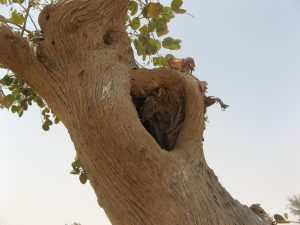Over 35 years ago, the Australian agronomist Tony Rinaudo began implementing what became known as Farmer Managed Natural Regeneration (FMNR). It all started in Maradi, Niger. Following the Beating Famine conference in Mali, Tony returned to Maradi, to visit friends and evaluate the impact of FMNR. He sent this report:
20 years after the formal closure of the project, FMNR continues to be popular in Maradi. The economic and food security benefits have been such that it has become integrated into the agricultural activity of the area, without the need for external support. These positive outcomes have had a ripple effect in the region, leading to villages that had not previously responded to FMNR taking it up with enthusiasm. The vulnerability of these communities to environmental shocks such as drought, windstorms and insect attacks has greatly reduced as a result of this.
I observed the beginnings of a virtuous cycle. More trees in the landscape and the decrease in the use of fire mean that there is now more fodder available, allowing farmers to keep more livestock. More organic matter is being returned to the soil, contributing to increased soil fertility and soil moisture holding capacity. In the past it was very rare to see free range poultry grazing, partly because of the scarcity of insects and seeds in the landscape, and partly because of the level of poverty of the community. This has changed.
More livestock (along with increased leaf litter fall and incorporation of crop residues) has resulted in increased soil fertility. This, in turn, has resulted in increased grain yields, and increased resilience against crop failure, even in years of lower rainfall and seasons with long dry spells in between rains. More tree cover has resulted in less wind damage and less soil erosion. Food security appears to have increased, as have income levels. Farmers now have more diversified income streams – from fodder, livestock, fuel wood and poles and also from introduction of crops which have not been grown in the region for decades, including sesame, cassava and sweet potato.
FMNR has also provided a foundation for agricultural diversification, with some farmers greatly increasing their income from honey, grafted zyzyphus, poultry and livestock. In the process, this has reduced their vulnerability to climatic shocks.
These findings point to the considerable contribution FMNR can make where drought, flood, low soil fertility and loss of biodiversity contribute to reduced options in fragile contexts. FMNR also can clearly lessen the stressors on vulnerable children.
It was of great interest to observe and learn about increased presence of birds and wildlife – including monkey sightings two years running in one village, monitor lizards, wild turkeys and numerous other bird species. I observed more older aged trees with hollows and suitable branches for nesting sites than on previous visits. Biodiversity is certainly benefiting from FMNR, and this feature should be factored into future grant proposals.
Of great concern for sustainable rural development is the high birth rate in Niger. The population is expected to double to 40 million by 2030! In combination with climate change impacts, this will undoubtedly undermine gains made through land restoration efforts. Future NRM projects could also include a contribution towards prolonging the schooling of girls and some family planning activities.
Another serious challenge is insecurity and conflict. The activities of extremist groups, bandits, kidnappers and extortioners could unravel all the gains made to date. It could be argued that the lack of opportunities in rural areas and very low farm incomes helps foster discontent and may be a factor in disaffected youth joining extremist groups.
Previous studies in Niger have shown that conflict between herders and farmers reduced by 70% as the availability of resources – fodder, food, fuel, water – increased. Building on potential synergies between land restoration and peacebuilding is a critical avenue of work which needs to be expanded.
In conclusion, the information gathered on this visit to Niger points to a much more productive landscape, thanks to the wide-spread adoption of FMNR. At the same time, efforts both to scale-up adoption and to consolidate the gains made so far need to be continued, in order to improve rural livelihoods in the Maradi region and beyond.
— Tony Rinaudo
